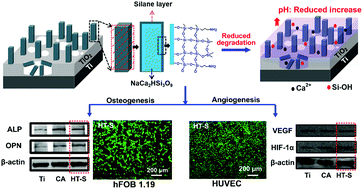当前位置:
X-MOL 学术
›
J. Mater. Chem. B
›
论文详情
Our official English website, www.x-mol.net, welcomes your
feedback! (Note: you will need to create a separate account there.)
Silanized NaCa2HSi3O9 nanorods with a reduced pH increase on Ti for improving osteogenesis and angiogenesis in vitro.
Journal of Materials Chemistry B ( IF 6.1 ) Pub Date : 2019-12-23 , DOI: 10.1039/c9tb02321f Kai Li 1 , Yang Xue 1 , Jianhong Zhou 2 , Jing Han 3 , Lan Zhang 1 , Yong Han 1
Journal of Materials Chemistry B ( IF 6.1 ) Pub Date : 2019-12-23 , DOI: 10.1039/c9tb02321f Kai Li 1 , Yang Xue 1 , Jianhong Zhou 2 , Jing Han 3 , Lan Zhang 1 , Yong Han 1
Affiliation

|
Extracellular Ca and Si can enhance the response of osteogenesis related cells and new bone formation. Calcium silicate-based ceramics are bioactive, biodegradable and can rapidly release large amounts of Ca and Si. However, the concurrently high pH value in the microenvironment induces cell injury, resulting in poor osseointegration and implant loosening. In this study, NaCa2HSi3O9 nanorods were initially fabricated on Ti by micro arc oxidation and hydrothermal treatment, and then covalently immobilized with a self-assembled NH2 functionalized silane layer. The microstructure and degradation behavior of the nanorods before and after silanization treatment were compared. Their osteoblast (hFOB1.19) and endotheliocyte (HUVECs) response in vitro was evaluated. After silanization treatment, an amorphous layer of silane networks with a thickness of 10 nm formed on nanorods, and this layer didn't change the coating microstructure obviously. It slightly decreased the hydrophilicity and acted as a barrier to isolate nanorods from directly contacting medium, resulting in a slower degradation rate. Silanized NaCa2HSi3O9 nanorods improved the adhesion and proliferation of HUVECs or hFOB1.19 compared with untreated nanorods and showed similar adhesion and proliferation but promoted differentiation of HUVECs and hFOB1.19 compared with TiO2. It is demonstrated that silanized NaCa2HSi3O9 nanorods allow efficient Ca and Si release and controlled pH increase. It should be a potential coating that can be applied on Ti implants.
中文翻译:

钛上pH降低的硅烷化NaCa2HSi3O9纳米棒可改善体外成骨和血管生成。
细胞外钙和硅可以增强成骨相关细胞的反应和新骨的形成。硅酸钙基陶瓷具有生物活性,可生物降解性,可以迅速释放大量的钙和硅。但是,同时在微环境中较高的pH值会引起细胞损伤,导致骨整合不良和植入物松动。在这项研究中,NaCa2HSi3O9纳米棒最初通过微弧氧化和水热处理在Ti上制备,然后与自组装的NH2官能化硅烷层共价固定。比较了硅烷化处理前后纳米棒的微观结构和降解行为。评估了它们的成骨细胞(hFOB1.19)和内皮细胞(HUVECs)的体外反应。硅烷化处理后 在纳米棒上形成了厚度为10 nm的硅烷网络非晶层,该层并没有明显改变涂层的微观结构。它略微降低了亲水性,并充当了隔离纳米棒与直接接触的介质的屏障,导致降解速度较慢。与未处理的纳米棒相比,硅烷化的NaCa2HSi3O9纳米棒改善了HUVECs或hFOB1.19的粘附和增殖,并且与TiO2相比,显示出相似的粘附和增殖,但促进了HUVECs和hFOB1.19的分化。结果表明,硅烷化的NaCa2HSi3O9纳米棒可有效释放Ca和Si,并控制pH的增加。它应该是可用于Ti植入物的潜在涂层。它略微降低了亲水性,并充当了隔离纳米棒与直接接触的介质的屏障,导致降解速度较慢。与未处理的纳米棒相比,硅烷化的NaCa2HSi3O9纳米棒改善了HUVECs或hFOB1.19的粘附和增殖,并且与TiO2相比,显示出相似的粘附和增殖,但促进了HUVECs和hFOB1.19的分化。结果表明,硅烷化的NaCa2HSi3O9纳米棒可有效释放Ca和Si,并控制pH的增加。它应该是可用于Ti植入物的潜在涂层。它略微降低了亲水性,并充当了隔离纳米棒与直接接触的介质的屏障,导致降解速度较慢。与未处理的纳米棒相比,硅烷化的NaCa2HSi3O9纳米棒改善了HUVECs或hFOB1.19的粘附和增殖,并且与TiO2相比,显示出相似的粘附和增殖,但促进了HUVECs和hFOB1.19的分化。结果表明,硅烷化的NaCa2HSi3O9纳米棒可有效释放Ca和Si,并控制pH的增加。它应该是可用于Ti植入物的潜在涂层。与未处理的纳米棒相比,图19所示的纳米棒具有相似的附着力和增殖能力,但与TiO2相比,可促进HUVEC和hFOB1.19的分化。结果表明,硅烷化的NaCa2HSi3O9纳米棒可有效释放Ca和Si,并控制pH的增加。它应该是可用于Ti植入物的潜在涂层。与未处理的纳米棒相比,图19所示的纳米棒具有相似的附着力和增殖能力,但与TiO2相比,可促进HUVEC和hFOB1.19的分化。结果表明,硅烷化的NaCa2HSi3O9纳米棒可有效释放Ca和Si,并控制pH的增加。它应该是可用于Ti植入物的潜在涂层。
更新日期:2019-12-23
中文翻译:

钛上pH降低的硅烷化NaCa2HSi3O9纳米棒可改善体外成骨和血管生成。
细胞外钙和硅可以增强成骨相关细胞的反应和新骨的形成。硅酸钙基陶瓷具有生物活性,可生物降解性,可以迅速释放大量的钙和硅。但是,同时在微环境中较高的pH值会引起细胞损伤,导致骨整合不良和植入物松动。在这项研究中,NaCa2HSi3O9纳米棒最初通过微弧氧化和水热处理在Ti上制备,然后与自组装的NH2官能化硅烷层共价固定。比较了硅烷化处理前后纳米棒的微观结构和降解行为。评估了它们的成骨细胞(hFOB1.19)和内皮细胞(HUVECs)的体外反应。硅烷化处理后 在纳米棒上形成了厚度为10 nm的硅烷网络非晶层,该层并没有明显改变涂层的微观结构。它略微降低了亲水性,并充当了隔离纳米棒与直接接触的介质的屏障,导致降解速度较慢。与未处理的纳米棒相比,硅烷化的NaCa2HSi3O9纳米棒改善了HUVECs或hFOB1.19的粘附和增殖,并且与TiO2相比,显示出相似的粘附和增殖,但促进了HUVECs和hFOB1.19的分化。结果表明,硅烷化的NaCa2HSi3O9纳米棒可有效释放Ca和Si,并控制pH的增加。它应该是可用于Ti植入物的潜在涂层。它略微降低了亲水性,并充当了隔离纳米棒与直接接触的介质的屏障,导致降解速度较慢。与未处理的纳米棒相比,硅烷化的NaCa2HSi3O9纳米棒改善了HUVECs或hFOB1.19的粘附和增殖,并且与TiO2相比,显示出相似的粘附和增殖,但促进了HUVECs和hFOB1.19的分化。结果表明,硅烷化的NaCa2HSi3O9纳米棒可有效释放Ca和Si,并控制pH的增加。它应该是可用于Ti植入物的潜在涂层。它略微降低了亲水性,并充当了隔离纳米棒与直接接触的介质的屏障,导致降解速度较慢。与未处理的纳米棒相比,硅烷化的NaCa2HSi3O9纳米棒改善了HUVECs或hFOB1.19的粘附和增殖,并且与TiO2相比,显示出相似的粘附和增殖,但促进了HUVECs和hFOB1.19的分化。结果表明,硅烷化的NaCa2HSi3O9纳米棒可有效释放Ca和Si,并控制pH的增加。它应该是可用于Ti植入物的潜在涂层。与未处理的纳米棒相比,图19所示的纳米棒具有相似的附着力和增殖能力,但与TiO2相比,可促进HUVEC和hFOB1.19的分化。结果表明,硅烷化的NaCa2HSi3O9纳米棒可有效释放Ca和Si,并控制pH的增加。它应该是可用于Ti植入物的潜在涂层。与未处理的纳米棒相比,图19所示的纳米棒具有相似的附着力和增殖能力,但与TiO2相比,可促进HUVEC和hFOB1.19的分化。结果表明,硅烷化的NaCa2HSi3O9纳米棒可有效释放Ca和Si,并控制pH的增加。它应该是可用于Ti植入物的潜在涂层。









































 京公网安备 11010802027423号
京公网安备 11010802027423号